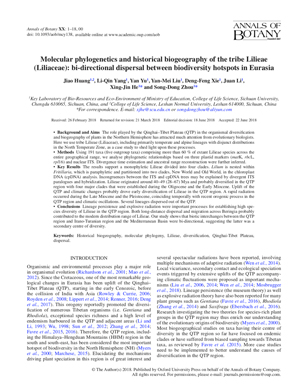NEWS 2018
Molecular phylogenetics and historical biogeography of the tribe Lilieae (Liliaceae): bi-directional dispersal between biodiversity hotspots in Eurasia
Jiao HUANG1,2, Li-Qin YANG1, Yan YU1, Yan-Mei LIU1, Deng-Feng XIE1, Juan LI1, Xing-Jin HE1, Song-Dong ZHOU1
Annals of Botany (2018)
http://dx.doi.org/10.1093/aob/mcy138
1Key Laboratory of Bio-Resources and Eco-Environment of Ministry of Education, College of Life Science, Sichuan University, Chengdu 610065, Sichuan, China
2College of Life Science, Leshan Normal University, Leshan 614000, Sichuan, China
Abstract
Background and Aims: The role played by the Qinghai–Tibet Plateau (QTP) in the organismal diversification and biogeography of plants in the Northern Hemisphere has attracted much attention from evolutionary biologists. Here we use tribe Lilieae (Liliaceae), including primarily temperate and alpine lineages with disjunct distributions in the North Temperate Zone, as a case study to shed light upon these processes.
Methods: Using 191 taxa (five outgroup taxa) comprising more than 60 % of extant Lilieae species across the entire geographical range, we analyse phylogenetic relationships based on three plastid markers (matK, rbcL, rpl16) and nuclear ITS. Divergence time estimation and ancestral range reconstruction were further inferred.
Key Results: The results support a monophyletic Lilieae divided into four clades. Lilium is nested within Fritillaria, which is paraphyletic and partitioned into two clades, New World and Old World, in the chloroplast DNA (cpDNA) analysis. Incongruences between the ITS and cpDNA trees may be explained by divergent ITS paralogues and hybridization. Lilieae originated around 40–49 (28–67) Mya and probably diversified in the QTP region with four major clades that were established during the Oligocene and the Early Miocene. Uplift of the QTP and climatic changes probably drove early diversification of Lilieae in the QTP region. A rapid radiation occurred during the Late Miocene and the Pleistocene, coinciding temporally with recent orogenic process in the QTP region and climatic oscillations. Several lineages dispersed out of the QTP.
Conclusions: Lineage persistence and explosive radiation were important processes for establishing high species diversity of Lilieae in the QTP region. Both long-distance dispersal and migration across Beringia probably contributed to the modern distribution range of Lilieae. Our study shows that biotic interchanges between the QTP region and Irano-Turanian region and the Mediterranean Basin were bi-directional, suggesting the latter was a secondary centre of diversity.




